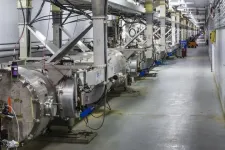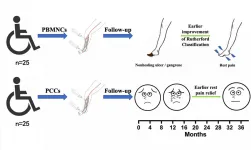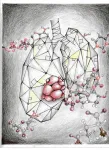(Press-News.org) Microscopy -- Nanoscale commuting
Oak Ridge National Laboratory's Center for Nanophase Materials Sciences, or CNMS, contributed to a groundbreaking experiment published in Science that tracks the real-time transport of individual molecules.
A team led by the University of Graz, Austria, used unique four-probe scanning tunneling microscopy, or STM, to move a single molecule between two independent probes and observe it disappear from one point and instantaneously reappear at the other.
The STM, made available via the CNMS user program, operates under an applied voltage, scanning material surfaces with a sharp probe that can move atoms and molecules by nudging them a few nanometers at a time. This instrument made it possible to send and receive dibromoterfluorene molecules 150 nanometers across a silver surface with unprecedented control.
"The project showcases precision instrument capabilities at the atomic level that open new frontiers in controllable molecules, or molecular machinery, for CNMS users," said ORNL's An-Ping Li.
Media Contact: Ashley Huff, 865.241.6451, huffac@ornl.gov
GIF: https://www.ornl.gov/sites/default/files/2021-01/6mb_gif.gif
Caption: The animation depicts the controlled transport of a single molecule between two scanning tunneling microscope tips in an experiment at ORNL. Credit: Michelle Lehman/ORNL, U.S. Dept. of Energy
Transportation - Easy on the pedals
Fuel economy can take a tumble when temperatures plummet, according to the Department of Energy's 2021 Fuel Economy Guide. Compiled by researchers at Oak Ridge National Laboratory, the guide includes several tips to improve a vehicle's fuel performance.
Parking your car in a warmer place, combining trips so that the vehicle is driven with a warm engine, and checking tire pressure regularly can all improve fuel economy. Driving sensibly, observing the speed limit, and limiting idling can also save money year-round.
"Many people think idling to warm up a car will improve fuel economy in cold weather," ORNL's Stacy Davis said.
"However, cars warm up faster when driven, and idling gets zero miles per gallon. So, idle your vehicle as little as possible."
The guide also helps consumers select the most fuel-efficient vehicle to save fuel and money in any weather.
Media Contact: Jennifer Burke, 865.414.6835, burkejj@ornl.gov
Image: https://www.ornl.gov/sites/default/files/2021-01/Transportation%20-%20Easy%20on%20the%20pedals.jpg
Caption: The 2021 Fuel Economy Guide, compiled by ORNL researchers, provides tips for keeping fuel costs down and helps consumers find the most fuel-efficient vehicle. Credit: ORNL/U.S. Dept. of Energy
Manufacturing - Defect detection
Algorithms developed at Oak Ridge National Laboratory can greatly enhance X-ray computed tomography, or XCT, images of 3D-printed metal parts, resulting in more accurate, faster scans.
Industrial XCT is gaining popularity as a way to nondestructively inspect and qualify additively manufactured, or AM, parts. But the process is hampered by an effect called beam hardening that can affect the ability of standard algorithms to resolve small defects, such as pores and cracks, in reconstructed images.
To improve the process, ORNL researchers demonstrated a new method using a deep neural network trained on simulated data from computer-aided design models and physics-based information. The method reduces noise and artifacts and produces higher quality images significantly faster than typical algorithms.
"We aim to enhance the resolution and defect detectability in X-ray images which, in turn, will be instrumental for qualification and certification of AM parts," said ORNL's Amir Ziabari.
Media Contact: Stephanie Seay, 865-576-9894, seaysg@ornl.gov
Image: https://www.ornl.gov/sites/default/files/2021-01/Manufacturing%20-%20Defect%20detection%201.jpg
Caption: A standard X-ray CT image of a 3D-printed metal turbine blade shows beam hardening and streaking effects. Credit: Amir Ziabari/ORNL, U.S. Dept. of Energy
Image: https://www.ornl.gov/sites/default/files/2021-01/Manufacturing%20-%20Defect%20detection%202.jpg
Caption: An X-ray CT image of a 3D-printed metal turbine blade was reconstructed using ORNL's neural network and advanced algorithms. Credit: Amir Ziabari/ORNL, U.S. Dept. of Energy
INFORMATION:
Five years after the Paris climate agreement, all eyes are on the world's progress on the road to a carbon-free future. A crucial part of this goal involves the energy transition from fossil fuels to renewable sources, such as sun, water, wind and wave energy. Among those, solar energy has always held the highest hope in the scientific community, as the most reliable and abundant energy source on Earth. In recent decades, solar cells have become cheaper, more efficient, and environment friendly. However, current solar cells tend to be opaque, which prevents their wider use and integration into everyday materials, constrained to being lined up on roofs and in remote solar farms.
But ...
Operators of the primary particle accelerator at the U.S. Department of Energy's Thomas Jefferson National Accelerator Facility are getting a new tool to help them quickly address issues that can prevent it from running smoothly. A new machine learning system has passed its first two-week test, correctly identifying glitchy accelerator components and the type of glitches they're experiencing in near-real-time.
An analysis of the results of the first field test of the custom-built machine learning system was recently published in Physical Review Accelerators and Beams.
The Continuous Electron Beam Accelerator Facility, ...
Microorganisms are the most abundant and diverse form of life on Earth. However, the vast majority of them remain unknown. Indeed, only a small fraction of the microorganisms of our planet can be cultured under traditional conditions, leaving a world of unculturable organisms out of our scope. This is especially true for bacteria thriving under extreme conditions as the harsh conditions are hardly reproducible in a lab. While some microbial studies have been performed in the Sahara, the Atacama, and the Gibson desert, European arid lands remain poorly studied.
To finally explore the microbial community of some European deserts, researchers ...
An effective response to a pandemic like the COVID-19 will only be successful if people voluntarily follow the rules and guidelines of decision-makers and experts. Many of the required measures, such as avoiding social contact and significantly changing our daily habits require a strong commitment. Other necessary actions, such as regular hand washing, are often impossible to monitor and enforce. Adherence to the guidelines thus depends on people's personal commitment.
The ability of policy makers and experts to communicate convincingly to citizens has a strong influence on whether ...
CORVALLIS, Ore. - Co-developing land for both solar photovoltaic power and agriculture could provide 20% of total electricity generation in the United States with an investment of less than 1% of the annual U.S. budget, a new paper by Oregon State University researchers found.
Wide-scale installation of agrivoltaic systems could lead to an annual reduction of 330,000 tons of carbon dioxide emissions in the U.S - the equivalent of 75,000 cars off the road per year - and the creation of more than 100,000 jobs in rural communities, while minimally impacting crop yield, the researchers say.
"Agrivoltaics provide a rare chance for true synergy: more food, more energy, lower water demand, lower carbon emissions, and more prosperous rural communities," said Chad Higgins, an associate ...
Durham, NC - Mid-term results of the first clinical trial designed specifically to evaluate the safety and effectiveness of two cell therapies that are showing early promise in treating angiitis-induced critical limb ischemia were released today in STEM CELLS Translational Medicine. The study, by researchers at Zhongshan Hospital/Fudan University in Shanghai, compared how transplantation of peripheral blood mononuclear cells fared versus transplantation of purified CD34+ cells in treating this condition.
It revealed both therapies yielded satisfactory results and provided evidence for ...
DALLAS - Jan. 5, 2021 - Researchers at the Children's Medical Center Research Institute at UT Southwestern (CRI) have discovered a new metabolic vulnerability in a highly aggressive form of non-small cell lung cancer (NSCLC). These findings could pave the way for new treatments for patients with mutations in two key genes - KRAS and LKB1. Patients whose tumors contain both of these mutations, known as KL tumors, have poor outcomes and usually do not respond to immunotherapy.
"We used to think that most tumors rely on the same handful of metabolic pathways to grow, but we've learned over the last decade that this is an oversimplification. Instead, different tumor subclasses have particular metabolic needs arising from mutations ...
Trio of articles suggest that a single dose of vaccine, even if less effective than two doses, may have greater population benefit.
Three articles published today in Annals of Internal Medicine discuss the most effective vaccination strategy for maximum impact against the COVID-19 pandemic. The articles are accompanied by an editorial from Thomas J. Bollyky, JD, Director of Global Health Program, Council on Foreign Relations. Mr. Bollyky can be reached through Lauran Potter at lpotter@cfr.org. The full text of his editorial is available here: https://www.acpjournals.org/doi/10.7326/M20-8280.
Speed Versus Efficacy: Quantifying Potential Tradeoffs in COVID-19 Vaccine Deployment https://www.acpjournals.org/doi/10.7326/M20-7866.
Researchers from Yale School of Public ...
The combination of ibrutinib plus rituximab is approved for the treatment of adults with previously untreated chronic lymphocytic leukaemia (CLL). In an early benefit assessment, the German Institute for Quality and Efficiency in Health Care (IQWiG) now examined which advantages and disadvantages this drug combination has for the patients. For patients who could also be treated with the chemo-immunotherapy FCR, the assessment found an indication of a major added benefit in comparison with this appropriate comparator therapy. No study data are available for patients for whom FCR or other chemo-immunotherapy is not an option due to their poorer general health. An added benefit is therefore ...
PULLMAN, Wash. - In what may be a sign of climate-change-induced conflict, researchers have captured rare photographic evidence of a jaguar killing another predatory wild cat at an isolated waterhole in Guatemala.
In the footage, a male jaguar arrives near the waterhole and apparently lies in wait for an hour. It lets a potentially dangerous prey animal, a large tapir, pass by, but when the ocelot stops to drink, the jaguar pounces and carries off the smaller predator.
The event, detailed in a recent study published in the journal Biotropica, was captured in the Maya Biosphere Reserve in March 2019, a dry month in a drought year for the tropical forest, by wildlife ecologists from Washington State University ...




